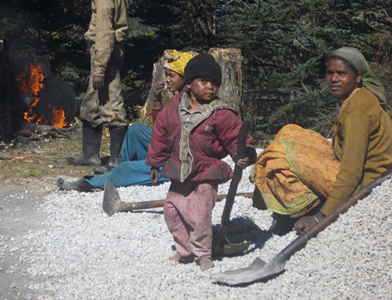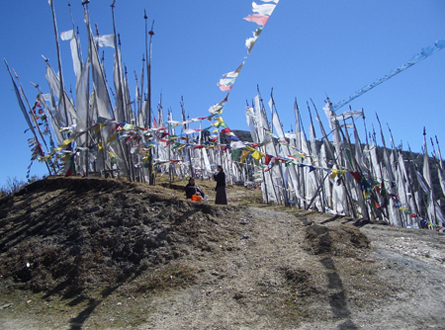MONTESSORI PROJECT
|
Click on these dates/links, to see Susan's emails and pictures Bhutan 2008 — Main page for 2008 trip |
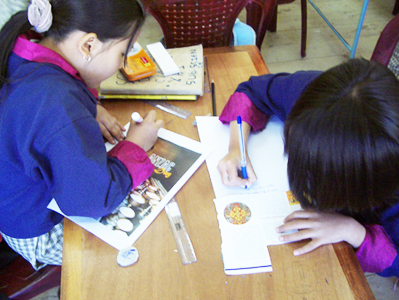 |
 |
Children in the school in Paro making books and writing letters for Susan to take to students in the USA. |
This book page shows pictures of life in Bhutan, flora, fauna, dress. |
LAST EMAIL FROM BHUTAN 2008 Tomorrow morning Gunilla and I will leave for Thailand and will spend 4 days out in the country where she lives in Tatum, going over everything we have done here to make sense of it, and to make a plan to support Montessori education in Bhutan. |
One of the students came to Gunilla in school this morning and told her that her mother had been afraid to come to our meeting last night, but after a few minutes there felt calm and peaceful and was no longer afraid. She had shared with her child about all of the things we covered. She told her about the value of having no TV or scary movies for children, about what children need such as to be included in the real work of the family, about how toys are usually a waste of time. She shared many other things, and told her child that she wanted a copy of the DVD's we showed because the children were so good, she said there was no hitting. We had shown, in the 1.5 hour session, two short videos from NAMTA and AMI/USA, both excellent introductions. |
|
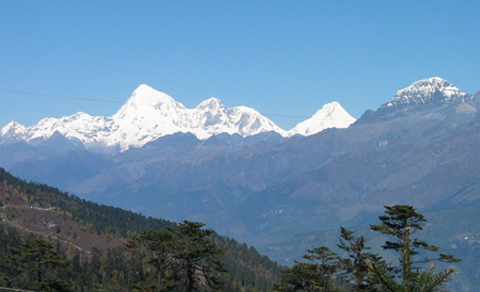 |
Road workers with a 1-year work visa from India. |
The sacred mountains of Jhomolhari and Jhodaka |
THE ROAD TO HAA Okay, back to yesterday, the trip to Haa. On the way up the mountain to the highest pass with a road in Bhutan we saw many groups of people from India working on the roads. They were melting tar, spreading tar, carrying boulders, smashing boulders, carrying rocks. All construction on the roads, just like the construction of buildings, is done by hand. Back in India these people would be lucky to earn about one US dollar a day for this kind of hard work. Out of that they would have to pay for a place to live, food, all living expenses. In Bhutan they earn about the same amount but they have a place to sleep and food. Many people from India apply to come and work and the lucky ones are given a 1-year visa to do this. Then they get to take home almost all of the money they earn in that year. |
JHOMOLHARI - THE SACRED MOUNTAIN As we drove on Dendy suddenly slammed on the breaks because, through the trees, she could see the tip of the famous mountain on the Bhutan/Tibet border, Jhomolhari! She has been to Haa many, many times and it had been years since she had been fortunate enough to see this sacred mountain. She was very excited. As we climbed higher and higher we could see more and more of this beautiful always-snow-covered mountain till at the top we could see all and the rest of the mountains in this, the beginning of the Himalayan range in Bhutan. There was not a cloud in the sky. Dendy said it was very auspicious, lucky, rare. |
|
 |
Susan, Gunilla, Dendy, having tea and praying on the Cheli la pass |
Dendy's family farmhouse, the architecture of all farmhouses in Bhutan |
CHELI LA PASS—A BLESSING We reached the top of the pass and sat down amongst the prayer flags to have our tea. This is one of the most beautiful spots, most holy spots, in Bhutan, covered with literally thousands of pray flags, and an ancient incense burner (4 feet high) with incense always kept burning. It felt like such a blessed day that I asked Dendy and Gunilla if they would say a prayer for the continuation of the Michael Olaf Company and our Montessori work in this terrible economic situation in the USA. So we all said our own silent prayers, one in English, one in Swedish, one in Dzongka. We opened our eyes at the same time, and suddenly a ferocious wind came up and started blowing the prayer flags. It was really amazing. Each and every one of the prayer flags, from the strings of tiny 5" flags, to the 20' tall polls with many, many flags in the Bhutanese style were not just fluttering, but straining against their polls and strings. |
THE FARMHOUSE More "Practical Life of Bhutan" Both Dendy (the Montessori teacher) and Chencho (her husband) were born and grew up in working farms in traditional 3 or 4 story farmhouses with no heat and no water. Each house has a kitchen, a main bedroom, a small sitting room and a large and beautifully decorated shrine room, where ceremonies are carried out and the family prays. |
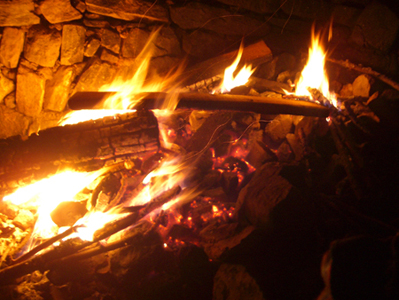 |
 |
| After two hours the rock are ready to heat the bath. | They are lifted out one at a time with long-handled metal tongs. |
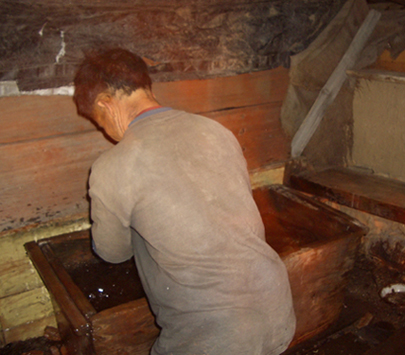 |
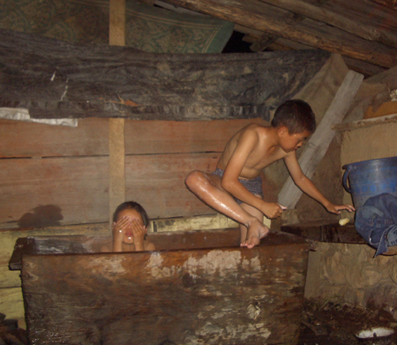 |
Passing, a family friend, places each rock in the bathtub. |
Omo and Kinley love this bath, so deep and warm. |
BHUTANESE HOT ROCK BATH When the meal was finished, the hot stone bath was ready. Dendy hat phoned ahead that we were coming, so Passing, a man who has been with the family so long that he carried Chencho on his back when he was a child, had spent 2 hours making the fire and getting the stones hot. Then he had filled the wooden bathtub with cold water. The fire and tub were in a wooden hut behind the farmhouse. There was a wooden ceiling over the tub, but not over the fire. Passing picked up the stones one at a time with a long handled metal tongs, 4 feet long, and one by one put them in the water, heating the bath. The water sizzled as the rocks were dropped in, but after the water was warm enough they were pushed to one end so the children could get in the tub. |
This deep hot bath out in the fresh cold air of night is a special treat for the children since water is slow to come into the newer inside bathtub at home and never more than a few inches deep. Chencho's sister, Zom, who runs the farm (working in the traditional way, hard work each day in charge of the cows, milking, planting, harvest—beautiful for us to observe but a very difficult life) says that once a week she takes a hot stone bath. |
Return to the Bhutan Montessori Project home page — Bhutan, 2006 Return to Michael Olaf Children's Projects — Projects |
|
